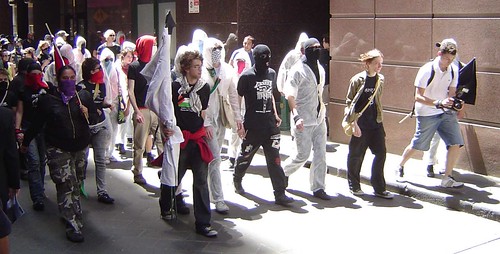“A few weeks ago”, writes Mel Campbell in ‘The street: just another fucking marketplace’ (Sydney Morning Herald, December 19, 2006), “workers gathered in capital cities to protest against the Work Choices industrial relations legislation. Union leaders had hoped for 100,000 protesters in Melbourne; estimates varied from 45,000 to 60,000. It wasn’t enough for the Prime Minister, John HoWARd, who deemed the low turnout a ringing endorsement of Work Choices. It suited him to make the number of people in the street directly representative of opinions on industrial reform. But just over a week earlier, HoWARd had decried the skirmishes outside the G20 conference as “thuggish behaviour” by “violent people who do not represent even the mainstream of people who oppose policies of this Government”.”
Herald Sun G20 fashion shoot : 1 | 2


Hey – I’m just wondering what your point is here, because I wasn’t writing about fashion at the G20. The part you’re quoting was about how politicians want to use the street as a barometer of public sentiment, but at the same time they ask the impossible of dissent in public, ie, that there be consensus among all protesters and that they protest in an ‘orderly’ manner.
Hi Mel,
Cool. You weren’t writing about fashion at the G20. So, by way of possible explanation:
I guess that, having read your article (which I found Googling News of ‘G20’), and having already noted the distinctive style of a number of the more militant protesters — which (for HoWARd) figured as being ‘unrepresentative’ — I thought titling the extract from your article in the light-hearted (?) manner in which I did — when supplemented by a photo and links to more — was kinda appropriate. Further, having read your article, I then looked at your blog, which IS about fashion (“street style”). (There is also the (implied) question of the relationship between ‘fashion’ — understood as being a form of (self-)representation — and ‘representational politics’ in general… a point which you pick up on and elaborate in your article.)
As for the article itself: I read it as being mainly concerned with the use and abuse of the notion of ‘the street’ (“an imaginary space – a rhetorical device that serves the purposes of whoever invokes it”) as the platform upon which more ‘authentic’ (and hence marketable) expressions of self may be discovered; a theme that’s kinda reminiscent of Frank’s ‘The Conquest of Cool’ (1997), related writings in ‘The Baffler’, and a previous train of cultural critique from which both draw heavily.
Finally, I agree with you that “It’s somewhat frustrating to have to compress so many ideas into the short length of an op-ed story – you could do better justice to this concept in an extended feature, and I would definitely like to write one”: this response was written at the end of a long day on a too-full stomach. That said, I’m not sure I understand or agree with your criticism of HoWARd’s posturing. Couldn’t it be argued that HoWARd is in fact being consistent? That is, neither the 45-60,000 unionists who marched in opposition to industrial relations ‘reforms’ (and in support of the ALP), or the far fewer G20 protesters who almost succeeded in destroying Western Civilization on November 18, 2006, are ‘representative’ of Mainstream Australia. Your point about politicians asking the impossible of public protest — that it be uniform in opinion and orderly in execution — seems to me to be a related but secondary one.
Cheers,
@ndy.